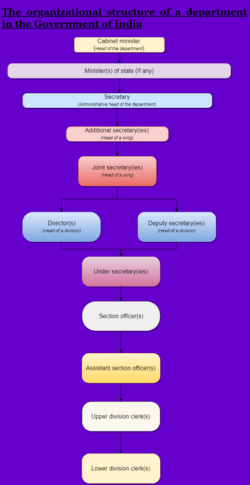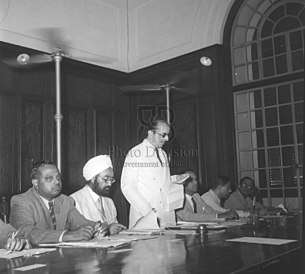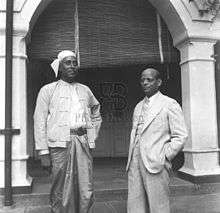Joint secretary to the Government of India
Joint Secretary (often abbreviated as JS, GoI) is a post under the Central Staffing Scheme[1] and the third[2] highest non-political executive rank[2] in Government of India. The authority for creation of this post solely rests with Cabinet of India.[3]
Joint secretary is an ex-cadre post, that means anyone can occupy it, but the position holder is mostly a career civil servant, generally from the Indian Administrative Service, and is a government official of high seniority.[4][5][6][7] The civil servants who hold this rank and post are either from All India Services (on deputation; on tenure, after empanelment) or Central Civil Services (Group A; on empanelment). All promotions and appointments to this rank and post are directly made by the Appointments Committee of the Cabinet of India.
In the functioning of Government of India, a joint secretary is the administrative head of a wing in a department.[8] Joint secretaries — on deputation — can hold senior positions at the United Nations, such as India's permanent representative to UNESCO.[9]
Joint secretaries in the Union Government[10][11][12] is analogous to major general[13] and equivalent ranks[14] in Indian Armed Forces and are listed as such in the Order of Precedence.[15][16][17][18] In the Cabinet Secretariat, the erstwhile military wing was headed by an officer from one of the three armed forces of the rank of major general and equivalent was given designated as Joint Secretary (Military).[19] The post is somewhat analogous to a secretary in a state government; however, office-bearers can hold senior positions such as that of principal secretary of a state government department,[20][21][22] and they can hold the position of the chief secretary of a Union Territory.
Joint secretaries rank 26th on Indian Order of Precedence.[15][16][17][18]
History
The post of joint secretary in the Government of India was created in the 1920s. The salary of a member in this rank and post was fixed at Rs. 36,000 per annum in the 1930s.[23] The salaries of Joint Secretary in Government of India during the British Raj was same to the Chief Secretary of United Provinces of Agra and Oudh, Punjab and Burma.[lower-alpha 1] As per Warrant of Precedence of 1905,[lower-alpha 1] joint secretaries in the Government of India were listed together with secretaries to the Government of India and ranked above of chief secretaries of provincial governments.[lower-alpha 1]
In 1937, the Central Secretariat contained only seven joint secretaries,[24] who were all members of the Imperial Civil Service. However, by 1946, the number had increased to twenty-five.
According to A. D. Gorwala, ICS, "The joint secretaries ought to in reality be what the name implies, namely secretaries for the subject entrusted to them and joined to a more senior secretary for the convenience of administrative work."[25] Sir Richard Tottenham, ICS had once expressed "In my opinion there is, or should be, no distinction of function, but only of pay between a joint and an additional Secretary. Additional and joint secretaries should not be either cheap secretaries or expensive deputy secretaries."[25]
During the tenure of Jawaharlal Nehru as the prime minister, the then Prime Minister's Secretariat was headed by a joint secretary.[26]
Powers, responsibilities and postings



Joint secretary is the overall in charge with the necessary measure of independent functioning and responsibility of the wing of the department allocated and entrusted to him.[27] A joint secretary in charge of Administration also exercises all administrative powers as head of the department wing of the ministry/department.[28]
Additional secretaries and joint secretaries are responsible for filing all affidavits and responses before the Supreme Court of India.[29][30]
The Prime Minister of India is the final authority on posting and transfer of officers of joint secretary level.[31] Joint secretaries report to their divisional/departmental additional secretary, departmental secretary and ministerial/departmental cabinet minister.
Position
In the Union government, the members head department wings in the departments and ministries of the Union government,[28] and hold positions such as chief vigilance officer (CVO),[32] chief administrative officer (CAO), emissaries in the foreign missions/embassies (ambassadors and ministers),[33] Registrar General and Census Commissioner of India, Director General of Civil Aviation of India,[34][35] director general of National Literacy Mission Authority, economic advisers, advisors of TRAI, Joint Directors of CBI,[36] additional directors general (AIR and Doordarshan),[37] board members of Staff Selection Commission of India[38] commissioners of Taxes and Police, chief engineers in central departments.
They also hold the post of Social Secretary and Press Secretary to President of India.
Government nominated Board members in the Central Public Sector Enterprises/Public Sector Undertakings are either of the rank of additional secretary or joint secretary.[39]
Emolument, accommodation and perks

All joint secretaries to the Government of India are eligible for a diplomatic passport. They are allotted Type-V (D-II and D-I) and Type-VI (C-II) apartments in areas like New Moti Bagh across Delhi by Ministry of Urban Development's Directorate of Estates.[40]
The salary and emolument in this rank is equivalent[14] to secretary to a state government and major general and equivalent ranks in Indian Armed Forces.[14][4]
| Base Salary as per 7th Pay Commission (Per month) | Level on Pay Matrix | Sources |
|---|---|---|
| ₹144,200 (US$2,000) (Minimum Pay) to ₹218,200 (US$3,000) (Maximum Pay) | Level 14 | [4][41] |
Reforms and challenges
In 2009, 20th Governor of Reserve Bank of India Bimal Jalan had voiced for posts at the level of joint secretary to be opened up to outside competition.[42]
Non-IAS civil services have complained to Government of India because of lack of empanelment in the rank/post of joint secretary on numerous occasions.[4][5][6][43][44][45] Still, According to the Seventh Central Pay Commission of India, IAS officers hold 249 out of 341 positions of Joint Secretary in the Government of India.[4]
In 2015, Government of India modified joint secretary-level empanelment process to ensure greater uniformity, consistency and transparency.[46] Under the prime ministership of Narendra Modi, however, the situation has slightly altered, choices for civil servants being appointed to this rank and post were from non IAS cadre.[47][48] Almost half the choices for the position have been given to Central Civil Services and All India Services (excluding IAS).[47][48]
In June 2018, Government of India — under Prime Minister Narendra Modi — announced opening up of 10 posts joint secretary in several departments to experts in several fields through lateral entry.
Notes
- 1 2 3 As per published records and book named "The India List and India Office List 1905" as published by India Office and India Office Records.
References
- ↑ "The Central Staffing Scheme" (PDF). Ministry of Personnel, Public Grievances and Pensions. January 1996. Retrieved 13 April 2016.
- 1 2 "Retd IAS Officer Moves SC Against Lateral Entry To Post Of Jt Secys". Livelaw.in. Retrieved 24 July 2018.
- ↑ "Only Cabinet can create Joint Secretary, above level posts". Press Trust of India. Retrieved 18 April 2017.
- 1 2 3 4 5 "Report of the 7th Central Pay Commission of India" (PDF). Seventh Central Pay Commission, Government of India. Archived from the original (PDF) on 2015-11-20. Retrieved 16 January 2016.
- 1 2 Tikku, Aloke (15 January 2016). "Parity between IAS and non-IAS? The IAS will get to decide". Hindustan Times. Retrieved 13 August 2017.
- 1 2 Dastidar, Avishek G (14 January 2017). "Alleging bias, non-IAS officers petition PM Modi". The Indian Express. Retrieved 13 August 2017.
- ↑ "Sahai appointed Joint Secretary NSCS: ACC Appointment". Greater Kashmir. 18 October 2016. Archived from the original on 20 October 2016. Retrieved 3 October 2017.
- ↑ "Archive: JS-level posts vacant at Centre, few takers". Business Standard. Archived from the original on 6 November 2016. Retrieved 6 November 2016.
- ↑ Cherian, Dilip (6 November 2016). "Dilli Ka Babu: Permanent Representative of India in Unesco an IAS post". Deccan Chronicle. Archived from the original on 6 November 2016. Retrieved 3 October 2017.
- ↑ "Part I of the Constitution of India- The Union and its territory - Article 1" (PDF). Ministry of Law and Justice, Government of India. Retrieved 15 January 2018.
- ↑ "Part XIV of the Constitution of India- Finance, Property, Contracts and Suits - Article 300" (PDF). Ministry of Law and Justice, Government of India. Retrieved 6 October 2017.
- ↑ "Part XIV of the Constitution of India- Services under the Union and the States - Article 312(2)" (PDF). Ministry of Law and Justice, Government of India. Retrieved 16 August 2017.
- ↑ Dutta, Sujjan (28 October 2017). "Govt 'clarifies', soldiers upset". The Telegraph. Retrieved 3 October 2017.
- 1 2 3 "Army Officers Pay Rules, 2017: Government of India" (PDF). Ministry of Defence (India). Retrieved 23 May 2017.
- 1 2 "Order of Precedence" (PDF). Rajya Sabha. President's Secretariat. 26 July 1979. Retrieved 24 September 2017.
- 1 2 "Table of Precedence" (PDF). Ministry of Home Affairs, Government of India. President's Secretariat. 26 July 1979. Retrieved 24 September 2017.
- 1 2 "Table of Precedence". Ministry of Home Affairs, Government of India. President's Secretariat. Retrieved 24 September 2017.
- 1 2 Maheshwari, S.R. (2000). Indian Administration (6th ed.). New Delhi: Orient Blackswan Private Ltd. ISBN 9788125019886.
- ↑ "History of Integrated Defence Staff, India". Ministry of Defence, India. January 2013. Retrieved 3 May 2014.
- ↑ "Three more IAS officers from state posted as joint secretaries in Modi govt". The Indian Express. 2 April 2015. Retrieved 3 October 2017.
- ↑ "Yogi Adiyanath seeks former Gorakhpur DM as Principal Secretary". The Indian Express. 23 March 2017. Retrieved 3 October 2017.
- ↑ "Awanish Kumar Awasthi appointed Principal Secretary to UP CM". Business Standard. 11 April 2017. Retrieved 3 October 2017.
- ↑ Kirk-Greene, A. (2000). Britain's Imperial Administrators, 1858-1966. New York City: Springer. ISBN 9780230286320.
- ↑ Maheshwari, S. B. (2001). Indian Administration (Sixth ed.). Orient Blackswan. p. 666. ISBN 9788125019886.
- 1 2 Jayapalan, N. (2001). Indian Administration 2 Vols. Set. Atlantic Publishers & Distri. p. 668. ISBN 9788171569212.
- ↑ Mehta, Dalpat Singh (1968). Handbook Of Public Relations In India. New Delhi: Allied Publishers. p. 135. ISBN 978-8170233343.
- ↑ "Powers and Duties of Officers and Employees as defined in the Manual of Office Procedure". Department of Industrial Policy and Promotion. 21 August 2014. Retrieved 21 August 2014.
- 1 2 "Central Secretariat Manual of Office Procedure - 14th Edition (2015)" (PDF). Ministry of Personnel, Public Grievances and Pension. p. 6. Retrieved 15 November 2016.
- ↑ "Delhi Confidential: New Respons(e)ibility". The Indian Express. 11 January 2017. Retrieved 3 October 2017.
- ↑ "SC against filing of affidavit below officer of Jt Secy level". Press Trust of India. 10 January 2017. Retrieved 3 October 2017.
- ↑ "PM to oversee cadre allocation of bureaucrats, postings of joint secretaries and above". The Times of India. 21 August 2014. Retrieved 17 September 2017.
- ↑ "No foreign job for babus who fail to join as CVOs: Centre". The Economic Times. 17 November 2015. Retrieved 18 November 2015.
- ↑ "MEA Moves its Men, Post-Haste". The Sunday Standard. 2 March 2014. Retrieved 12 March 2014.
- ↑ "Civil aviation ministry embraces new year with top-level changes". The Sunday Standard. 31 December 2014. Retrieved 2 May 2014.
- ↑ "Joint secretary Kumar proposed as new DGCA". The Times of India. 27 December 2013. Retrieved 2 May 2014.
- ↑ "Sanctioned Strength of Central Bureau of Investigation – Executive Officers" (PDF). Central Bureau of Investigation. 3 February 2014. Retrieved 1 August 2014.
- ↑ "Sheheryar, First Kashmiri Appointed as Director General All India Radio". freepresskashmir.com. 3 February 2014. Archived from the original on 26 February 2014. Retrieved 14 June 2014.
- ↑ "Selection of Appointment of Member of Staff Selection Commission of India" (PDF). Minister of Home Affairs (India). 27 December 2013. Retrieved 2 May 2014.
- ↑ "CHAPTER II PERSONNEL POLICIES (b) Composition of Board of Directors" (PDF). Department of Public Enterprises, Government of India. Retrieved 12 January 2018.
- ↑ "Compendium (RTI Act) – Government Residence (General Pool in Delhi) Rules" (PDF). Directorate of Estates, Ministry of Urban Development. January 2013. Retrieved 21 July 2014.
- ↑ Biswas, Shreya, ed. (29 June 2016). "7th Pay Commission cleared: What is the Pay Commission? How does it affect salaries?". India Today. Retrieved 24 September 2017.
- ↑ "Bring in experts. Snip away red tape". Hindustan Times. 29 July 2009. Archived from the original on 14 March 2014. Retrieved 12 March 2014.
- ↑ Tripathi, Shishir (8 December 2015). "IAS: Emperor among the kings?". Governance Now. Retrieved 13 August 2017.
- ↑ "Non-IAS bureaucrats now eligible for secretary-level posts". The Asian Age. 18 January 2016. Retrieved 13 August 2017.
- ↑ "Need Pay Parity With IAS Officers, Say Officials Of 20 Civil Services". NDTV. 30 June 2016. Retrieved 13 August 2017.
- ↑ "Joint Secretary-Level Empanelment Process Modified". The Sen Times. 1 June 2015. Retrieved 1 June 2015.
- 1 2 "Non-IAS officers are top choices for Modi government for the crucial Joint Secretary positions". The Economic Times. 18 February 2016. Retrieved 15 July 2016.
- 1 2 Roche, Elizabeth; Aggarwal, Mayank (14 July 2016). "Govt appoints 28 officers, half non IAS, to joint secretary level posts". Live Mint. HT Media Ltd. Retrieved 3 October 2017.
Bibliography
- Maheshwari, S.R. (2000). Indian Administration (6th ed.). New Delhi: Orient Blackswan Private Ltd. ISBN 9788125019886.
- Kirk-Greene, A. (2000). Britain's Imperial Administrators, 1858-1966. New York City: Springer. ISBN 9780230286320.
- Jayapalan, N. (2001). Indian Administration 2 Vols. Set. Atlantic Publishers & Distri. ISBN 9788171569212.
- Mehta, Dalpat Singh (1968). Handbook Of Public Relations In India. New Delhi: Allied Publishers. ISBN 978-8170233343.